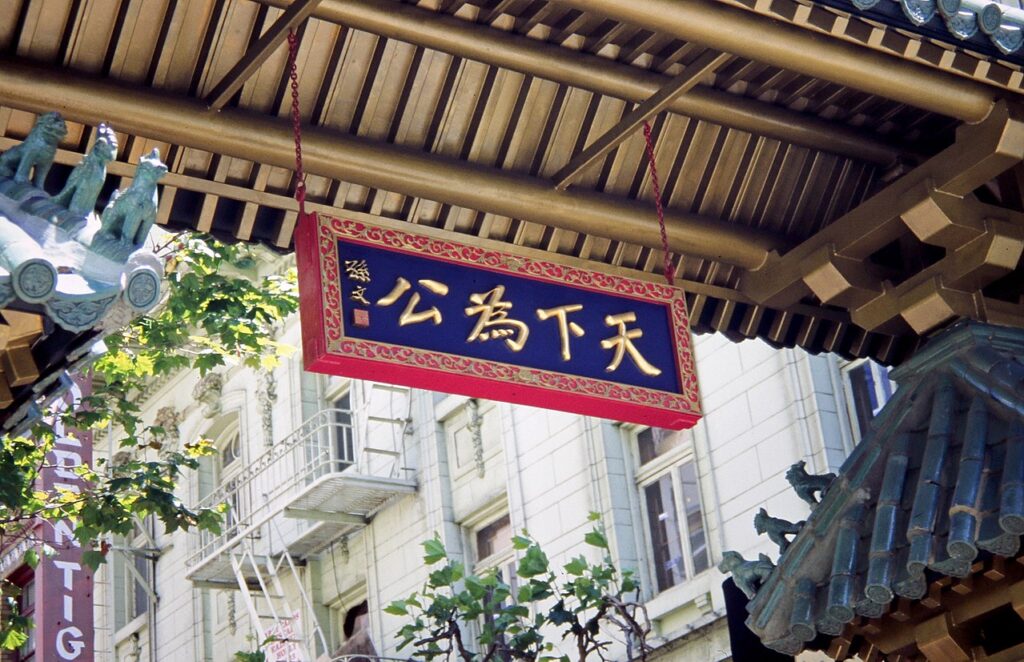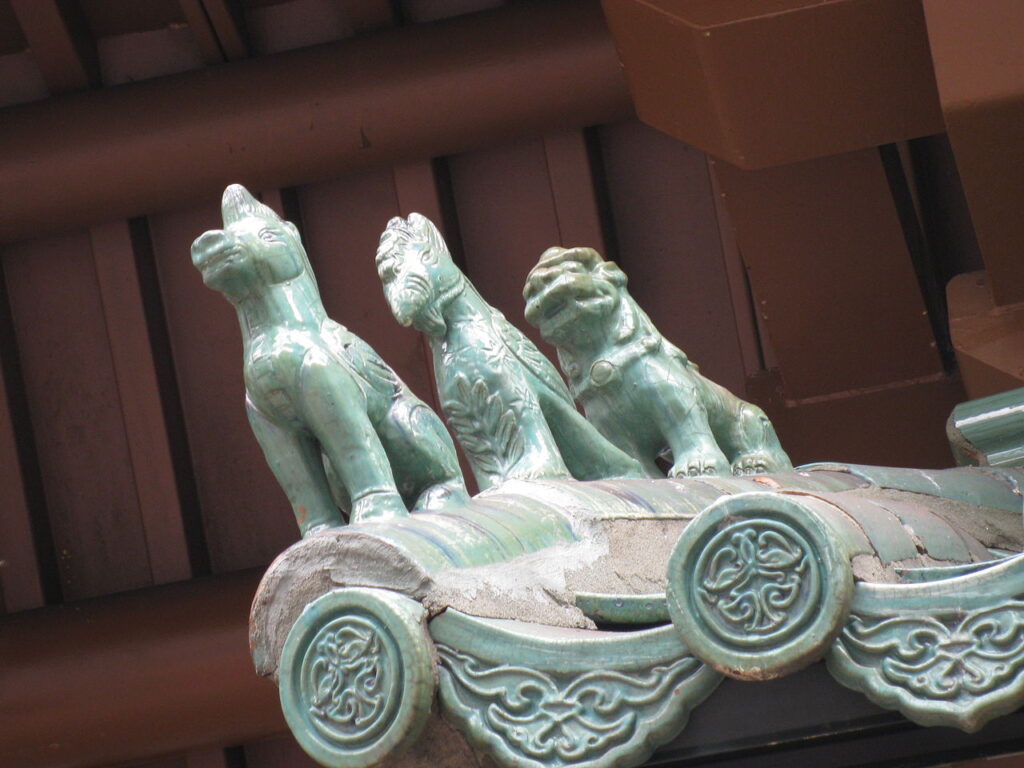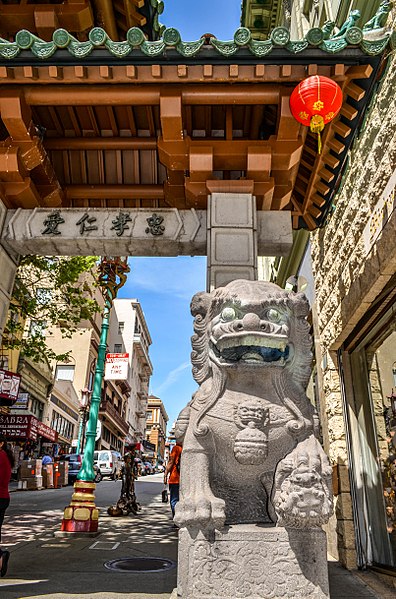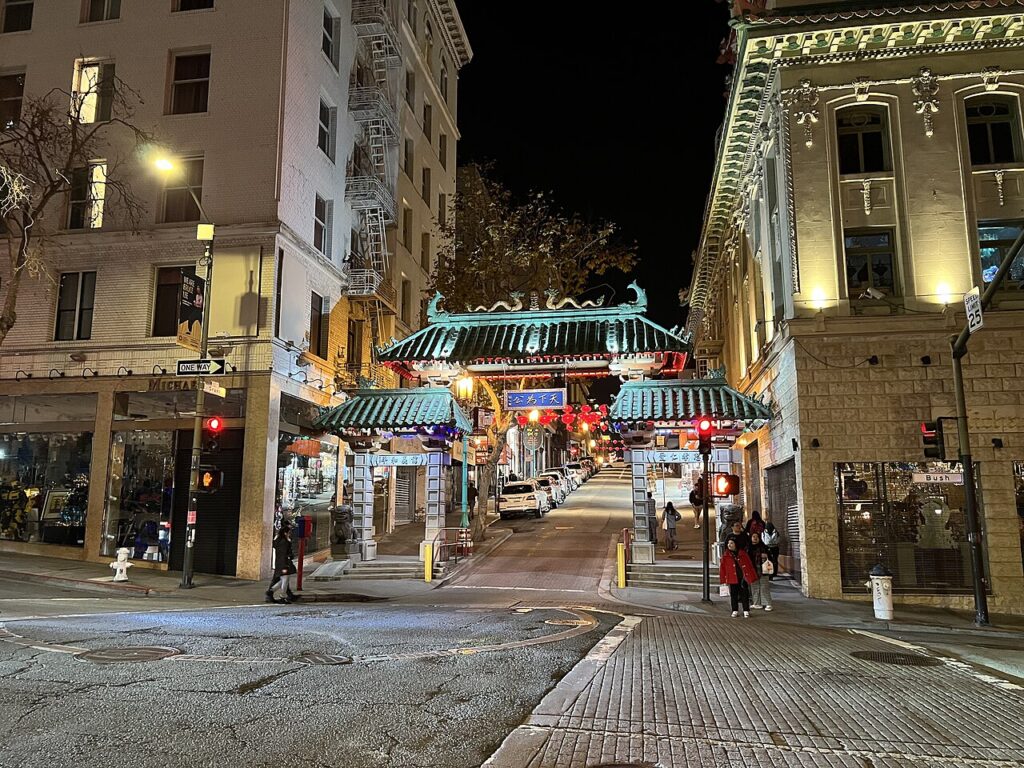CALL US! 1-415-766-2722
Fun@SanFranciscoJeepTours.com
Like most Chinese ceremonial gates, the Chinatown Gateway has three portals facing south. The two smaller west and east (pedestrian) portals flank the larger central (automotive) portal, and the structure is supported on stone columns rising from the sidewalks on either side of Grant.
The stone columns adhere to standards for Chinese gateways in contrast, most ‘Chinese’ gateways constructed in the United States use wooden support columns. Each portal is covered with green tiles, leading north along Grant Avenue into Chinatown.
Three shallow steps lead up to each pedestrian portal. Each pedestrian portal features a stone Chinese guardian lion on the side away from the street. By tradition, the lion pair consists of one male and one female. The male lion, at the west portal, stands with his right fore paw atop a pearl or stone, symbolically guarding the structure or empire. The female lion, at the east portal, stands with her left fore paw atop a juvenile lion, symbolically guarding the occupants within

There are four Chinese characters above each portal. Each sign is read from right to left.

Beyond the Dragon Gate lies the bustling streets of Chinatown, a neighborhood that has preserved its unique identity while continuously evolving. Today, Chinatown is a dynamic blend of the old and new, where historic temples and traditional herbal shops coexist with contemporary art galleries and trendy eateries. As visitors pass through the gate, they step into a world that offers a tangible connection to Chinese culture, history, and the immigrant experience in America.

The main thoroughfare of Chinatown, lined with shops selling everything from fine teas to handcrafted souvenirs, offering a glimpse into the commercial heart of the community.
Housing an extensive collection of artifacts and exhibits, this museum provides insights into the Chinese American experience from the Gold Rush to the present day.
Chinatown is renowned for its culinary offerings, with numerous restaurants serving authentic dim sum, Peking duck, and other traditional Chinese dishes.

Address: The intersection of Grant Avenue and Bush Street, San Francisco, CA 94108
The Dragon Gate is more than just a physical entryway into San Francisco’s Chinatown; it’s a symbolic passage into a world that bridges continents and centuries. Whether you’re drawn by the lure of history, the promise of culinary delights, or the beauty of traditional architecture, Chinatown and its iconic gate offer a unique and enriching experience. It’s a reminder of the city’s multicultural tapestry and a tribute to the Chinese American community’s resilience and contributions to San Francisco’s cultural and social fabric.
Chinatown Gate Information and copyright – https://en.wikipedia.org/wiki/Dragon_Gate_(San_Francisco)
For travelers who crave flexibility and exclusivity, a private Jeep tour offers the best way to explore San Francisco. Whether you want to dive into history, enjoy nature, or capture perfect cityscapes, we tailor your tour to match your vision.
✅ Handpicked Itinerary: From the Golden Gate Bridge to Sausalito, every stop is your choice.
✅ Stress-Free Exploration: No big groups or time constraints—just a personalized adventure.
✅ Local Expertise: Your private tour guide shares hidden gems and fascinating stories.
✅ Breathtaking Views: Our Jeeps provide the best photo ops across the city.
For an unparalleled San Francisco tour, book a private group tour and experience the city like never before!
The Dragon Gate is the ceremonial entrance to San Francisco’s Chinatown, marking the beginning of historic Grant Avenue. It’s one of the city’s most photographed landmarks and a popular picture stop on San Francisco Jeep Tours.
The gate sits at the intersection of Bush Street and Grant Avenue, on the southern edge of Chinatown—just steps from Union Square.
The Dragon Gate was completed in 1970. It was designed by Chinese-American architect Clayton Lee, with artistic contributions from Chinatown sculptor Haig Patigian.
The gate represents a traditional paifang, welcoming visitors into Chinatown.
Its design features:
Ornamental dragons for strength and protection
Guardian lions to ward off bad spirits
Green tiled roofs inspired by classic Chinese architecture
A symbolic inscription meaning “All under heaven is for the good of the people.”
Yes—it’s one of the top Instagram spots in San Francisco.
Best angles:
Standing on Grant Avenue looking north into Chinatown
Wide angle from the Bush Street crosswalk
Photo with the guardian lion statues on each side
Often, yes. Depending on traffic and guest preference, your private Jeep Tour may include a quick hop-off photo stop right at the gate or a slow roll-by for photos.
The guardian lions—one male and one female—are traditional protectors believed to bring good fortune and balance. They mark the entrance as a place of cultural significance.
Yes. Pedestrians can walk directly beneath the gate along Grant Avenue.
Yes. The gate is softly illuminated in the evenings, making it a beautiful stop during Sunset and night tours. San Francisco Jeep Tours City Lights Tour.
No. Visiting and photographing the Dragon Gate is free and open to the public, 24/7.
Nearby points of interest within a short walk include:
Chinatown’s Grant Avenue shops
Old Saint Mary’s Cathedral
Stockton Street Markets
Portsmouth Square
Waverly Place and Chinatown temples
Union Square, just one block south
The gate photographs well all day, but the best times include:
Morning for fewer crowds
Golden hour for warm sunlight on the rooftops
Evening for lantern lights glowing above Grant Avenue
It symbolizes the city’s deep Chinese heritage, marks the entrance to America’s oldest Chinatown, and has become a cultural emblem representing San Francisco’s diversity, architecture, and history.
About a 10-minute drive or 20–25 minutes by cable car, depending on route. Most San Francisco Jeep Tours include a Chinatown drive-through that passes near the gate.
Yes. The sidewalks around the Dragon Gate are wide and fully accessible, and nearby intersections are signalized for easy crossing. There is an uphill section as you travel down Grant Street
